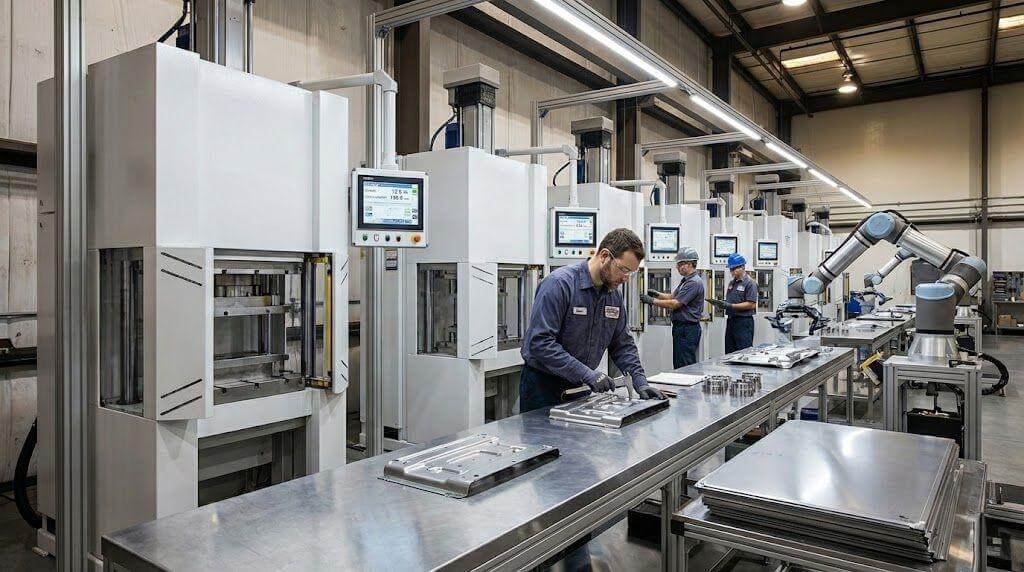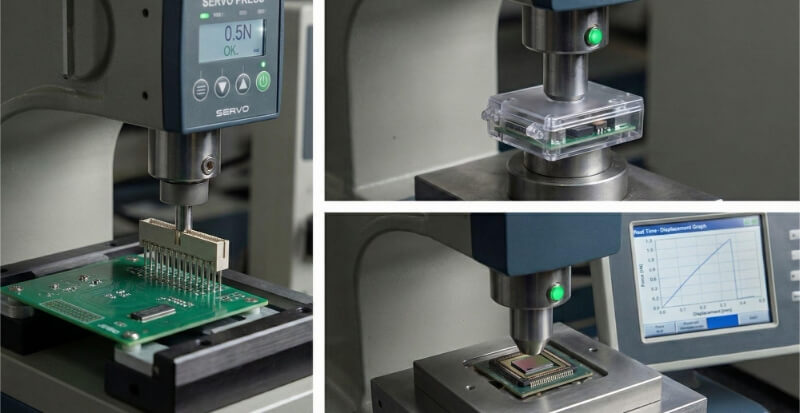多くの産業は、耐久性と性能の両方を提供する材料に依存しています。タングステンはそのユニークな特性から選ばれることが多いが、その高密度が最も際立っている。この特性は、エンジニアリング、製造、エレクトロニクスにおける設計上の難題を解決することができます。専門家にとって、タングステンの密度が製品やプロセスにどのような影響を与えるかを理解することは、十分な情報に基づいた選択を行うための鍵となります。
タングステンの密度は、人々が実際のプロジェクトでそれを使用する方法を形作ります。このたった一つの特性が、どのような違いを生むのか、探る価値はある。

タングステンとは何か?
タングステンは硬い灰色の金属で、融点が非常に高い。また、非常に緻密で強い。タングステンは、高熱や高圧を扱う工具、電子機器、機械などに使用されています。
タングステンの原子番号は74。記号はWで、"wolfram "に由来する。74個の陽子と電子を持ち、強い結合を可能にする複雑な構造を持つ。
周期表では第6族と第6周期に属する。遷移金属に属する。これらの金属は、その靭性と優れた電気的および熱的特性で有名である。
タングステンは自然界に純粋な形で存在するわけではない。タングステンは通常、鉄マンガンや鉄マンガンのような鉱物から採掘される。採掘後、金属粉に精製され、固形物に加工されます。
タングステンの密な原子構造が、その高密度と重量の主な要因である。各原子が密に詰まることで、狭い空間での重量が増す。これが高密度の理由である。
密度を理解する
密度とは、ある空間にどれだけの質量が詰まっているかを示すものです。これは、特にタングステンのような金属を表す最も基本的な方法のひとつです。
密度とは何か、どうやって測るのか?
密度とは物体の質量を体積で割ったものです。公式は次の通り:
密度=質量÷体積
密度を測定するには、まず物質の重さを量って質量を求めます。次に大きさを測って体積を求めます。例えば、立方体の体積は、長さ、幅、高さを掛け合わせ て計算する。
両方の数値がわかったら、質量を体積で割る。その結果が材料の密度となる。
この特性は、大きさの割に「重い」と感じる素材の比較に役立つ。小さなタングステンの塊は、大きなアルミニウムの塊よりも重く感じる。
メートル法と帝国法における密度の単位
メートル法では、密度は通常、グラム毎立方センチメートル(g/cm³)またはキログラム毎立方メートル(kg/m³)で示される。
例えば、こうだ:
- 水 = 1 g/cm³
インペリアル法では、密度はポンド毎立方インチ(lb/in³)またはポンド毎立方フィート(lb/ft³)で表示される。
材料選択における密度の重要性
密度は、製品における材料の挙動に影響を与えます。タングステンのような密度の高い素材は重量を増し、バランス、安定性、振動制御に役立ちます。
設計において密度は、強度や耐久性、あるいは必要に応じて軽量化するためにどのような材料を使うべきかをエンジニアが判断するのに役立ちます。また、輸送コストや扱いやすさにも影響する。
航空宇宙やスポーツ用具のような特定の用途では、低密度の金属が軽量化につながる。カウンターウェイトや装甲のような他の用途では、高密度が望ましい。
タングステンの密度
タングステンの密度は、その最も定義的な特徴の一つである。この高密度は、要求の厳しい用途において多くの利点をもたらします。
室温での標準密度
室温(20℃前後)では、タングステンの標準密度は 19.25グラム/立方センチメートル(g/cm³)である。
これにより、タングステンの密度は鉛の約2倍、アルミニウムの約4倍となる。タングステンはほとんどの使用温度で安定しており、一般的な環境では密度が大きく変化することはありません。
タングステンの密度(g/cm³、kg/m³、lb/in³単位
タングステンの密度を標準単位で表すとこうなる:
- 19.25 g/cm³ (グラム毎立方センチメートル)
- 19,250 kg/m³ (キログラム/立方メートル)
- 0.694 lb/in³ (ポンド/立方インチ)
これらの値は、ユーザーが好む測定システムに基づいて使用されます。アメリカのエンジニアはlb/in³を使うかもしれないが、他のほとんどの人はg/cm³またはkg/m³を使う。
なぜタングステンは超高密度材料と言われるのか?
タングステンは最も重い天然元素のひとつである。その原子は巨大で、ぎっしりと詰まっている。この高密度の原子構造がタングステンの重さを生み出している。
比較するために:
- 鉛:11.34 g/cm³
- スチール:7.85 g/cm³
- タングステン19.25 g/cm³
このため、タングステンは小さくても重くなければならない部品に最適です。カウンターウェイト、放射線シールド、軍用ハードウェア、高密度工具などに使用されています。

タングステン密度に影響を与える要因
タングステンの密度は高いが、いくつかの条件によってわずかに変化することがある。これらの要因は、材料が実際の使用でどのように振る舞うかに影響します。
温度と相変化
温度が上がると、ほとんどの材料は膨張する。タングステンもそうですが、ごくわずかです。
高温になると、タングステンの原子は離れ、体積が増加する。質量は一定のままなので、密度はわずかに減少します。この変化は通常軽微であり、ほとんどの用途に大きな影響を与えることはありません。
タングステンが溶融時や気化時などの極端な高温に達す ると、相変化によって密度がより顕著に変化することがあ る。しかし、タングステンの溶融温度は3,422℃(6,192°F)であるため、日常的な使用ではこのようなことはほとんど起こりません。
他の元素との合金化
純粋なタングステンが最も密度が高い。他の元素と混ぜて合金にすると、通常密度は下がります。
例えば、こうだ:
- タングステン銅 の製造に使用されている。 ヒートシンク や電気部品に使用される。これらは純粋なタングステンよりも密度が低い。
- 炭化タングステン切削工具によく使われるタングステンは密度が高いが、それでも純タングステンよりわずかに低い。
合金は原子構造と原子間隔を変化させ、密度に直接影響する。エンジニアは、材料を選択する際にこのことを考慮しなければならない。
製造プロセスと純度レベル
タングステンの加工方法も最終密度に影響する。
タングステンは粉末冶金で作られることが多い。この方法では、タングステン粉末は、固体形状を形成するために押され、加熱される。このプロセスは完全に粉末を圧縮しない場合は、小さなエアポケットが残っている可能性があり、実際の密度を減らすことができます。
純度も重要です。純粋なタングステンは、理想的な19.25g/cm³に近い密度を持っています。材料に酸素、炭素、その他の汚染物質が含まれている場合は、密度が低くなることがあります。
高品質な製造により、よりタイトな結晶粒構造と少ないボイドが保証され、密度は理論値に近く保たれる。
タングステンの密度を活かした産業用途
タングステンの極端な密度は、コンパクトな質量や耐放射線性が重要な産業において、それをかけがえのないものにします。その主な用途を見てみましょう。
航空宇宙
航空機や人工衛星では、狭いスペースで重量のバランスを取る必要がある。タングステンは、多くの場合、航空機の制御面、ローターブレード、および衛星のコンポーネントのバラストとして使用されます。
宇宙での放射線遮蔽にも使われている。タングステンは、大きくてかさばる構造を必要とせずに有害な光線を吸収します。これは、繊細な電子機器や計器を保護しながら、ペイロードのサイズを小さくするのに役立ちます。
医学
タングステンは、がん治療の放射線療法において重要な役割を果たしている。健康な組織を保護するために、放射線ビームの集束や遮断に使用される。
CTスキャナーやX線装置では、タングステンのシールドが迷入放射線からユーザーを保護します。その高い密度は、他の金属よりも効果的に有害な光線を遮断するのに役立ちます。
ミリタリー
タングステンは徹甲弾に最適です。その密度は、金属装甲を貫通する重量と硬度を弾丸や砲弾に与えます。
また、ミサイル誘導システムやヘリコプターのローターのカウンターウェイトにも使われている。これらの部品は重いがコンパクトである必要がある。タングステンは、鉛や鋼よりもこのニーズに適しています。
タングステン合金とその密度
タングステン合金は、純粋なタングステンがあまりにも脆いか、またはで動作するように困難である場合に使用されます。これらの合金は、強度、加工性、および性能を向上させながら、タングステンの密度の多くを保持します。
炭化タングステンとその用途
炭化タングステンは、タングステンと炭素から作られる化合物である。金属合金ではなく、セラミックと金属の混合物(サーメット)である。密度は約15.6g/cm³で、純タングステンよりわずかに低い。
丈夫で耐摩耗性に優れている。そのため、次のような用途に最適です:
- 切削工具
- ドリルビット
- 金型
- 工業用ノズル
タングステンカーバイドは、鉱業、機械加工、自動車産業、航空宇宙産業などで広く使用されています。 金属加工.高圧下でも熱を加えても形状を維持するため、過酷な作業にも耐える。
重タングステン合金
これは、タングステンと少量のニッケル、鉄、銅を組み合わせた本物の金属合金である。
- W-Ni-Fe 合金は強靭で延性があり、機械加工が容易である。密度は17.0~18.5g/cm³である。
- W-Ni-Cu 合金は非磁性で、強度はやや低い。密度は同程度で、17.0~18.3g/cm³程度。
これらの合金は、航空宇宙、防衛、医療分野で使用されている。重量と靭性の組み合わせにより、厳しい環境下でも優れた性能を発揮します。
純タングステンとの密度の違い
純タングステンの密度は19.25g/cm³と最も高い。合金はより密度の低い金属を含むため、わずかに軽くなります。
例えば、こうだ:
- 純タングステン19.25 g/cm³
- 炭化タングステン15.6 g/cm³
- W-Ni-Fe:17~18.5g/cm³。
- W-Ni-Cu:17-18.3 g/cm³
選択は必要性による。最高密度が優先される場合は、純タングステンが良い選択です。加工性と強度を重視する場合は、合金の方が良い場合が多い。

タングステン密度の試験と検証
タングステンが性能のニーズを満たしていることを確認するには、その密度をテストする必要があります。これらの検査は、使用前に材料の品質、純度、一貫性を確認します。
ラボ試験法
アルキメデスの原理は密度測定の標準的な方法である。タングステンの試料を空気中で計量し、次に水中で計量する。その差から体積を計算します。密度は、質量を体積で割ったものです。
この方法は簡単で、規則的な形状のソリッドパーツに効果的である。
蛍光X線分析(XRF)のようなX線技法は、材料の組成を確認するのに役立ちます。これらの検査は密度を直接測定するものではありませんが、純度レベルを確認することができます。タングステンの含有量が少ないサンプルは、当然密度が低くなります。
品質管理で使用するツール
製造チームは、精密なはかり、ノギス、マイクロメーターを使用して質量と体積を測定する。これにより、密度が許容範囲内にあるかどうかをチェックすることができる。
先進的な施設の中には、CTスキャンや超音波を使用して、実際の密度を低下させる可能性のある内部の空洞や欠陥を見つけるところもある。これらのツールは、航空宇宙や医療機器に使用される高精度部品に役立ちます。
硬度計も使用される。硬度計は密度に直接関係するものではありませんが、不適切な合金の配合や加工上の問題を検出するのに役立ちます。
低純度または規格外のタングステンの見極め
純度の低いタングステンは、見た目は普通でも、大きさの割に重く感じません。重量と体積を比較すると、密度が低すぎるかどうかがすぐにわかります。
赤信号には以下のようなものがある:
- 軽く感じる素材
- 凹凸のある、または多孔質の表面
- 加工結果が悪い
- 標準タングステンとの色の違い
サプライヤーは、密度、純度、および試験方法を記載した材料証明書を提供すべきである。これがないと、規格外の材料を受け取るリスクが高くなります。
結論
タングステンの密度は19.25g/cm³と非常に高く、工業用金属としては最も重い部類に入る。このたった一つの性質が、タングステンの強度、安定性、耐摩耗性、耐熱性を高めています。航空宇宙、医療、または工具の用途にかかわらず、その重量は、その性能を決定する上で重要な役割を果たしています。
仕様通りのタングステン部品が必要ですか?当社は、性能を要求される産業向けに、高精度のタングステン加工および製造サービスを提供しています。 今すぐお問い合わせください。!
よくあるご質問
なぜタングステンは高密度なのか?
タングステンの原子は非常に重く、密に詰まっている。それぞれの原子は原子番号が高く(74)、質量が大きい。原子同士が接近しているため、より多くの質量を小さな空間に収めることができる。これが高い密度を生み出している。
密度はタングステンのコストに影響するか?
ある意味ではそうだ。密度が高いということは、1個あたりの重量が増えるということだ。そのため、原材料や輸送コストが増加する。さらに、密度の高い金属は機械加工が難しく、製造コストが増加する可能性があります。しかし、価格は純度、形状、供給条件にも左右される。
タングステンは最も密度の高い金属か?
タングステンは最も密度の高い金属のひとつだが、絶対的な密度ではない。
オスミウム そして イリジウム がやや濃い:
- オスミウム:~22.59 g/cm³
- イリジウム:~22.56 g/cm³
- タングステン:19.25 g/cm³
タングステンの方が入手しやすく、加工しやすい。そのため、最も密度が高くなくても、産業界でより頻繁に使用されている。
タングステンの密度は工具や機器の性能にどのように影響するか?
タングステンの密度は、バランスを改善し、振動を低減し、必要な部分に質量を加えます。工具では、強靭な材料の切断に役立ちます。機器では、安定性と耐摩耗性を向上させます。圧力下でも優れた性能を発揮し、過酷な条件下でも形状を保ちます。

ケビン・リー
レーザー切断、曲げ加工、溶接、表面処理技術を専門とし、板金加工において10年以上の実務経験があります。シェンゲンのテクニカルディレクターとして、複雑な製造上の課題を解決し、各プロジェクトにおける革新と品質の向上に尽力しています。




